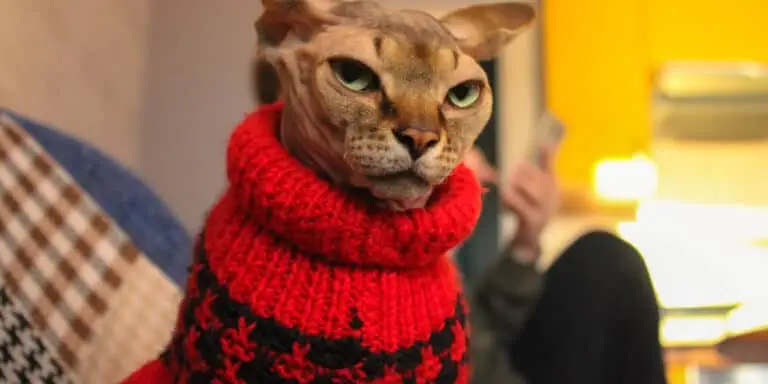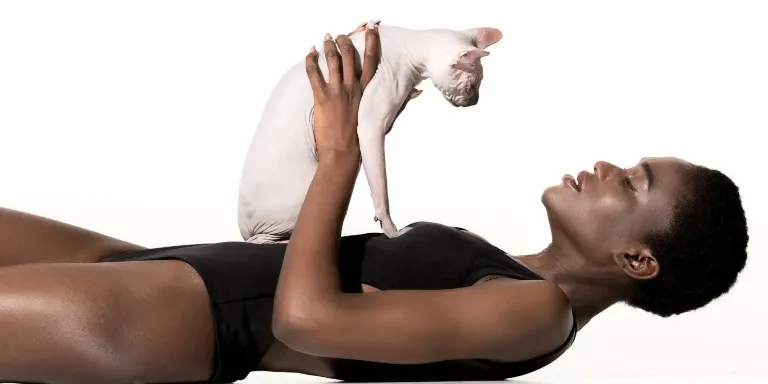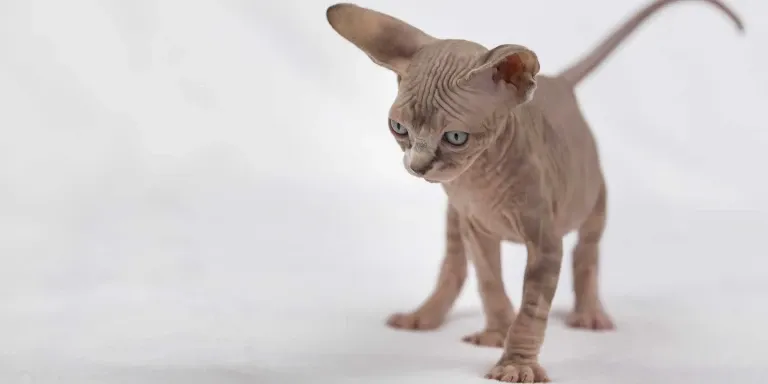The Best Fluffy Pancakes recipe you will fall in love with. Full of tips and tricks to help you make the best pancakes.

Have you ever wondered what that unique and mysterious creature with no hair is called? Well, you’re in for a treat! In this article, we’ll explore the fascinating world of hairless cats and uncover the secrets behind their genetic makeup.
The cat without hair is called a Sphynx cat.
From their intriguing history and origins to the different types and common characteristics, we’ll delve into everything you need to know about these enchanting feline companions.
So get ready to unravel the mysteries of the cat without hair and discover their truly captivating nature.
The Genetics Behind Hairless Cats
You should learn about the genetics behind hairless cats.
Understanding the genetic mutations that give rise to hairless cats can provide valuable insights into their breeding process.
Hairlessness in cats is primarily caused by a genetic mutation known as the ‘Sphynx gene.’ This gene affects the production of hair and results in cats being born without fur.
It’s a recessive gene, meaning that both parents must carry it in order for their offspring to be hairless.
Breeders carefully select cats with the Sphynx gene to ensure the continuation of this unique trait.
Through a controlled breeding process, hairless cats are produced, maintaining the genetic mutation that makes them distinct.
Studying the genetics behind hairless cats enables breeders to better understand and manage their breeding programs, ensuring the continued existence of these extraordinary feline companions.
History and Origins of Hairless Cat Breeds
If you want to learn about the history and origins of hairless cat breeds, it’s important to research their origins in different parts of the world.
Hairless cat breeds, such as the Sphynx and the Peterbald, have a fascinating historical significance.
The Sphynx, for example, originated in Canada in the 1960s, when a spontaneous genetic mutation led to a kitten being born without fur. This kitten was then bred to produce more hairless offspring, leading to the establishment of the Sphynx breed.
On the other hand, the Peterbald breed originated in Russia in the 1990s through selective breeding between hairless cats and Russian Domestic Shorthairs.
These hairless cat breeds have gained popularity over the years and are now recognized by various cat associations worldwide.
Understanding their historical significance can provide valuable insights into the development and evolution of these unique feline companions.
Different Types of Hairless Cats
When it comes to hairless cats, there are several different types to consider.
One popular breed is the Sphynx, known for its lack of fur and wrinkled skin.
Another breed is the Peterbald, which has a more slender body and a variety of coat types, including bald and brush.
Finally, there’s the Donskoy, which can have either a bald or a velour coat.
Each of these breeds has unique physical characteristics, genetic origins, and traits that make them fascinating to learn about.
Unique Physical Characteristics
Have you ever seen a hairless cat and marveled at its unique physical characteristics? Hairless cat breeds, such as the Sphynx and the Peterbald, are known for their lack of fur, revealing their smooth, wrinkled skin. Despite their lack of hair, these cats are still just as lovable and playful as their furry counterparts.
However, their skin requires special care to keep it healthy. To ensure proper skin care for your hairless cat, it’s important to regularly clean their skin with a gentle cleanser and moisturize it to prevent dryness. Additionally, protecting their skin from the sun’s harmful rays is crucial, as hairless cats are more prone to sunburn.
Remember to provide a warm and cozy environment for your hairless cat, as they may be more sensitive to temperature changes. By following these skin care tips, you can help your hairless cat stay happy and healthy.
Genetic Origins and Traits
Hairless cats are a result of genetic mutations that affect the development of their fur. There are several different breeds of hairless cats, each with its own unique genetic characteristics.
The Sphynx cat is one of the most well-known hairless breeds. It originated from a natural genetic mutation and is known for its lack of fur and wrinkled skin.
The Peterbald breed originated in Russia and is known for its slender body and elegant appearance. It was created through selective breeding and carries a gene that causes hairlessness.
The Donskoy cat also originated in Russia and is known for its unique appearance, with wrinkled skin and a lack of fur. It’s a result of a spontaneous genetic mutation.
While hairless cats may be intriguing, it’s important to note that they can have certain health concerns. Due to their lack of fur, they’re more susceptible to temperature changes and sunburn. Additionally, they may require more frequent bathing to maintain proper skin health. It’s important to provide them with proper care and attention to ensure their well-being.
Care and Maintenance Tips
Are you aware of the specific care and maintenance tips for different types of hairless cats?
Grooming techniques for hairless cats are essential to keep their skin healthy and free from irritations. Regular bathing is necessary to remove oils and debris from their skin. Use gentle, hypoallergenic shampoos specifically formulated for hairless cats to avoid skin drying. It’s important to moisturize their skin after bathing with a cat-friendly moisturizer or coconut oil.
Hairless cats are prone to sunburn, so provide them with a safe and shaded environment when outdoors. Additionally, they may need extra warmth during colder months, so consider providing them with a cozy blanket or heated pet bed. Consulting with a veterinarian can help you identify recommended products and develop a grooming routine that suits your hairless cat’s specific needs.
Common Characteristics of Hairless Cats
You’ll notice that hairless cats have a distinctive smooth and sleek appearance. They stand out from other cats due to their lack of fur, which is a result of genetic mutations. These mutations affect the production of hair follicles, resulting in cats that are born without fur or have only a small amount of hair.
Despite their lack of fur, hairless cats still possess unique characteristics that make them appealing to many pet owners. Some of these characteristics include:
- Hypoallergenic qualities: Hairless cats are often considered hypoallergenic because they produce fewer allergenic proteins found in cat dander, which can trigger allergies in some individuals.
- Warmth-seeking behavior: Due to their lack of fur, hairless cats have a higher body temperature and are known to seek out warm spots in the house or cuddle up with their owners for warmth.
- Increased grooming needs: While hairless cats may not require regular brushing like their furry counterparts, they still need regular bathing to remove oils and dirt from their skin.
Overall, hairless cats possess unique characteristics that make them a fascinating and appealing choice for cat lovers.
Caring for a Hairless Cat: Tips and Tricks
If you have a hairless cat, one useful tip is to provide them with a cozy and warm environment to help regulate their body temperature. Hairless cats, such as the Sphynx breed, lack the insulation that fur provides, making them more susceptible to temperature changes. To keep your hairless cat comfortable, consider providing them with a heated bed or a warm spot in your home.
Additionally, it’s important to pay close attention to their diet. Hairless cats have higher metabolism rates and may require more calories to maintain their body temperature. Consult with your veterinarian to ensure that your hairless cat is receiving the appropriate diet and nutrition.
Furthermore, grooming hairless cats is crucial to their overall well-being. Regular bathing is necessary to remove oils and debris from their skin. Be sure to use special cat-friendly shampoo and follow proper grooming techniques recommended by your veterinarian.
Health Considerations for Hairless Cats
To maintain the health of your hairless cat, it’s essential to regularly monitor their skin for any signs of irritation or infection. Hairless cats, also known as Sphynx cats, require special care due to their genetic health and grooming needs. Here are some key points to consider:
Genetic Health:
- Hairless cats are prone to certain genetic conditions, such as hypertrophic cardiomyopathy (HCM) and respiratory issues. Regular check-ups with a veterinarian are crucial to ensure their overall well-being.
- It’s important to obtain your hairless cat from a reputable breeder who conducts genetic testing to minimize the risk of inherited health problems.
Grooming Needs:
- Despite their lack of fur, hairless cats still require grooming. Their skin should be cleaned regularly to remove any excess oils or debris.
- Bathing should be done using a mild, hypoallergenic shampoo recommended by your veterinarian. Pay attention to their skin’s pH balance to prevent dryness or irritation.
- Moisturizing the skin with a cat-friendly lotion can help keep it hydrated.
The Unique Personality of Hairless Cats
Hairless cats have a knack for captivating their owners with their affectionate cuddling and playful antics. If you’re considering getting a hairless cat, it’s important to understand the unique personality traits that these cats possess.
Hairless cats are known for their friendly and social nature, making them great companions for individuals or families. They thrive on attention and love to be the center of attention. However, owning a hairless cat also requires some special considerations.
It’s essential to find reputable hairless cat breeders who prioritize the health and well-being of their cats. Additionally, grooming techniques for hairless cats differ from those of their furry counterparts. Regular bathing is necessary to keep their skin clean and healthy, and moisturizing is important to prevent dryness.
Overall, owning a hairless cat can be a rewarding experience, but it’s important to be well-informed about their unique needs.
Does the Lack of Fur in Sphynx Cats Affect Their Intelligence?
The lack of fur in Sphynx cats does not affect their intelligence. Sphynx cat intelligence traits are not related to their physical appearance. These cats are known to be smart, curious, and affectionate, regardless of their unique coat. Their intelligence is not determined by their lack of fur.
Final Thoughts
In conclusion, hairless cats, also known as Sphynx cats, are a unique and fascinating breed with a rich history and distinct characteristics.
Despite their lack of fur, they require special care and attention to maintain their health and well-being.
With their affectionate and playful personalities, these captivating creatures make wonderful companions for those willing to embrace their unconventional beauty.
As the saying goes, ‘Beauty is in the eye of the beholder,’ and for many, hairless cats are a true testament to this adage.








